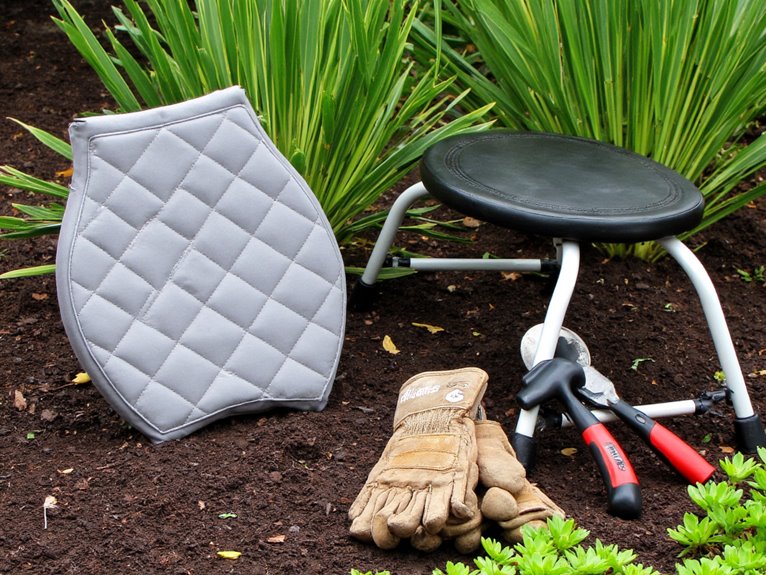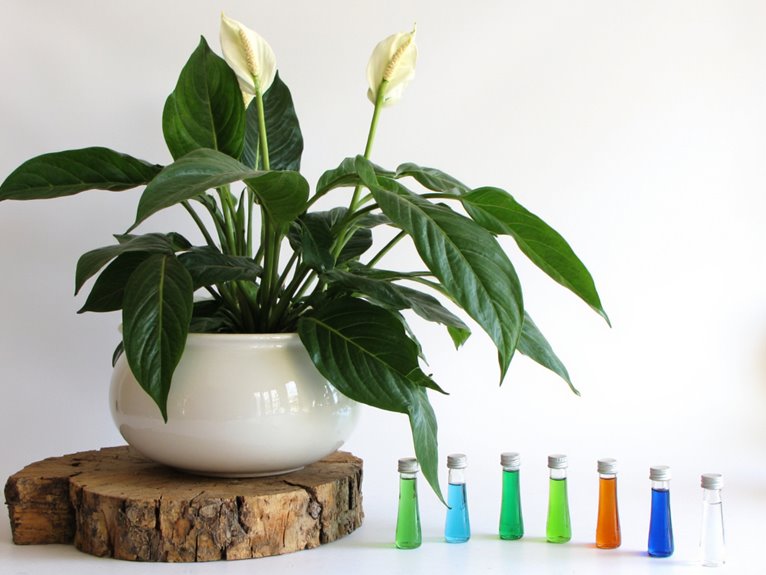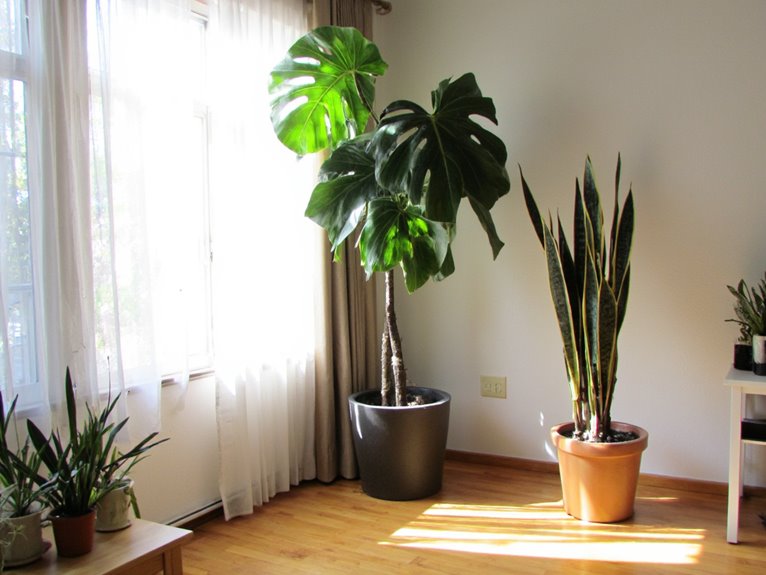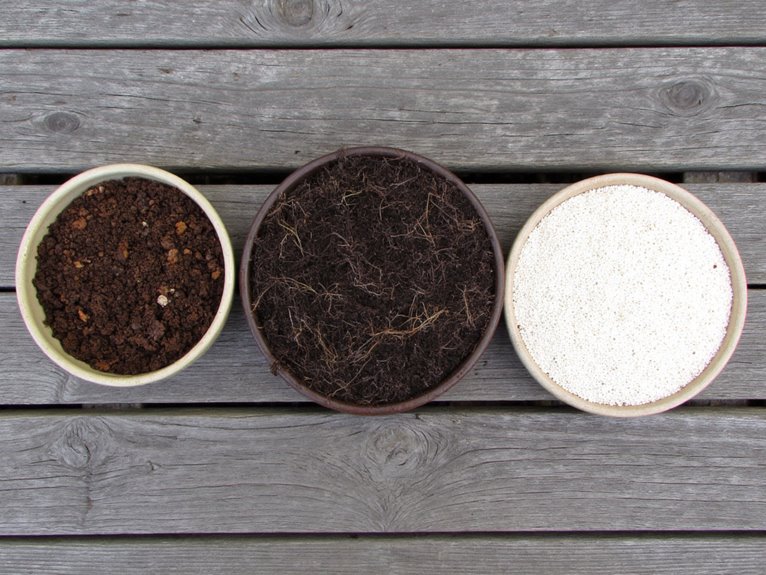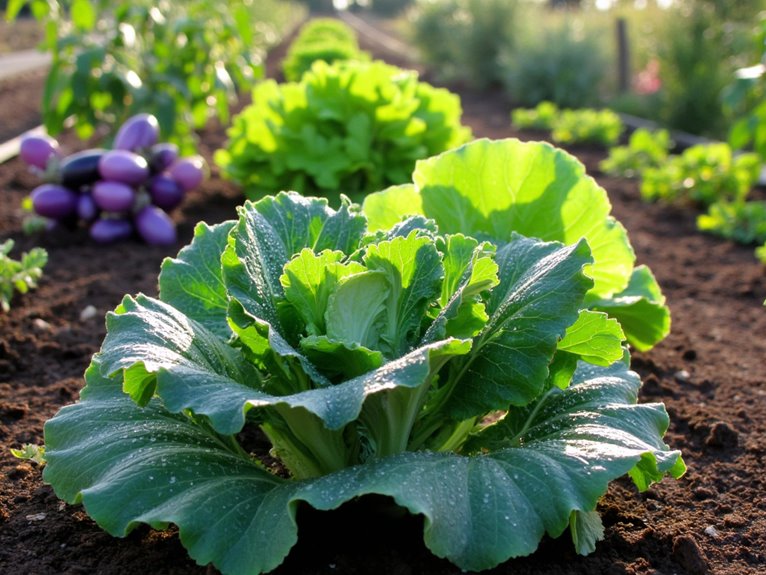DIY Potting Mix Recipe: Make Your Own Indoor Plant Soil
You can make a great indoor potting mix with peat moss or coco coir for moisture, perlite or vermiculite for drainage, and a bit of sand or bark for structure. For most plants, try equal parts of these ingredients to keep roots happy and soil from getting too soggy. If you’re growing succulents, add more perlite; for ferns, mix in some organic compost. Just remember to let the mix dry out between waterings and refresh it every few months with a bit of nutrient-rich top dressing. Want to know how to keep your plants pest-free and thriving? There’s more where this came from.
Notable Insights
- Mix equal parts peat moss or coco coir with perlite for good drainage and moisture retention in indoor potting mixes.
- Add sand or vermiculite to improve aeration, especially for succulents and epiphytic plants that need well-draining soil.
- For acid-loving plants, include pine mulch or sphagnum peat moss to maintain a slightly acidic pH level between 6.0-6.5.
- Use compost or worm castings as a natural nutrient source, adding them periodically to enrich the potting mix.
- Store homemade mix in sealed buckets in cool dark places and use within weeks for best results.
Essential Ingredients for a Balanced Indoor Potting Mix
Soil alone won’t cut it – indoor plants need a carefully balanced mix to thrive. The secret lies in finding the right aeration balance and moisture retention. Start with peat moss or coco coir, which hold water while keeping soil light. Add perlite or vermiculite to prevent compaction and guarantee air gets to roots. For epiphytic plants, toss in bark chips for extra aeration. Compost enriches the mix with nutrients and microbes, but don’t overdo it or you’ll drown your plants. The key is harmony: too much retention and roots suffocate; too little drainage and they rot. Experiment with ratios to match your plant’s needs – ferns prefer more moisture than succulents. Proper drainage becomes even more critical when paired with containers that have 40+ drainage holes to prevent root rot and ensure optimal water flow. With practice, you’ll create perfect conditions for every green thumb!
Custom Recipes for Different Plant Types
Tailored mixes open up plant potential, just as custom care routines do—think of your garden as a personalized ecosystem. For Aroid care, orchid bark, perlite, and Coco coir create rapid drainage while retaining moisture sustainably. Foliage plants benefit from peat moss or Coco coir blended with perlite and vermiculite. Succulents need ultra-drainage with perlite, vermiculite, and sand. Acid-lovers like blueberries require peat moss and pine mulch to maintain low pH. Loamy favorites mix prefab soil with sand for drainage.
Drainage optimization through perlite and vermiculite is crucial for preventing root rot in container plants.
| Plant Type | Key Ingredients |
|---|---|
| Orchids & Aroids | Orchid bark, perlite, Coco coir, horticultural charcoal |
| Foliage Houseplants | Peat moss/Coco coir, perlite, vermiculite |
| Succulents/Cacti | Perlite, vermiculite, coarse sand, peat/coir |
| Acid-Loving Trees | Peat moss (2 parts), perlite, pine mulch |
| Loamy Favorites | Prefab mix + sand, mushroom compost, balanced fertilizer |
These mixes address specific needs—Coco coir’s sustainability, rice hulls’ structure, and worm castings’ slow nutrients—letting you grow confidently with plants thriving in their perfect conditions. Quality potting soils usually incorporate peat moss and perlite as foundation ingredients for optimal moisture retention and drainage balance.
Mixing Techniques and Proportions
Once you’ve got your base mix sorted, it’s time to get hands-on with the real fun—figuring out how much of each ingredient to use and how to combine them without turning your garden into a science experiment. Use mixing tools like large buckets for initial soaking and separate containers for thorough blending. Aim for balanced ingredient ratios: equal parts peat/coir with perlite/sand often works well. Adjust based on texture—add sand if too sticky, peat if too sandy. Consistent measuring guarantees reliable results. Don’t forget to sift compost before mixing. Consider adding beneficial ingredients like earthworm castings or kelp meal to enhance nutrient content and improve plant growth. With practice, you’ll master the art of potting mix creation!
(Using vermiculite as a key component helps with moisture retention and aeration moisture retention)
Nutrient and Pest Management Tips
Whether you’re growing houseplants or a garden oasis, balancing nutrients and managing pests isn’t just important—it’s essential for keeping your green space thriving. Focus on nutrient cycling by regularly adding compost to replenish soil with organic matter and micronutrients. For pest identification, inspect leaves regularly for aphids, spider mites, or discolored spots. Use neem oil or diatomaceous earth as natural controls. Maintain pH between 6.0-7.0 for peak nutrient uptake. Adjust fertilization seasonally—boost nitrogen in spring, reduce it in autumn. Pair clean practices with early pest detection to protect your collection. With attention to these basics, your plants will flourish year-round.
Storage and Usage Best Practices
Although proper storage might seem simple, keeping your potting mix fresh requires attention to both container choice and environmental conditions—think sturdy buckets rather than plastic bags, and a cool, dark spot instead of a sunny windowsill. Choose ideal containers with secure lids that let air flow but prevent leaks, like 11L pails. Control moisture by storing the mix dry and checking regularly for condensation. Avoid airtight seals to maintain microbial activity. Use your potting mix within weeks to avoid nutrient buildup, and rotate stock so older mix comes out first. Before planting, loosen the soil and add fresh amendments if needed—your plants will thank you!
Frequently Asked Questions
Can I Use Garden Soil Directly for Indoor Plants?
No, you shouldn’t use garden soil directly for indoor plants. It’s heavy, compact, and prone to root rot in containers. Garden soil also contains microbes that can be unsanitary indoors. Instead, opt for sterile potting mix designed for Indoor plants.
How Do I Know if My Mix Is Too Dense or Compacted?
You can tell your mix is too dense if it feels hard to dig or has poor drainage. Check soil texture—compacted mix lacks air pockets, causing water to pool instead of drain. If plants struggle, that’s a sign of density issues needing fixing.
Is It Safe to Reuse Old Potting Mix for New Plants?
Yes, it’s safe to reuse old potting mix for new plants with proper methods. Use soil amendment like compost or perlite to improve texture and nutrients. Avoid diseased soil; instead, top-dress pots or blend with fresh mix. Clean the container too—your plants’ll thank you!
What’s the Best Way to Add Nutrients to a DIY Mix?
You should mix nutrient sources like compost varieties for organic matter and microbes, add slow-release fertilizers like Osmocote, and consider bone meal or kelp meal for specific nutrients. Test pH and adjust with limestone if needed.
Do I Need to Pasteurize My Homemade Potting Soil?
Yes, you should pasteurize your homemade potting soil to kill pests and pathogens. Pasteurization methods like oven heating or solarization are key soil sterilization techniques that improve plant health without fully destroying beneficial microbes.
On a final note
With a personalized potting mix, your indoor plants thrive with tailored care. Remember to balance ingredients like peat moss, perlite, and compost for ideal drainage and nutrition. Regularly check for pests and replenish nutrients as needed. Store your mix in a sealed container to maintain freshness. Happy planting—your green space will thank you!


